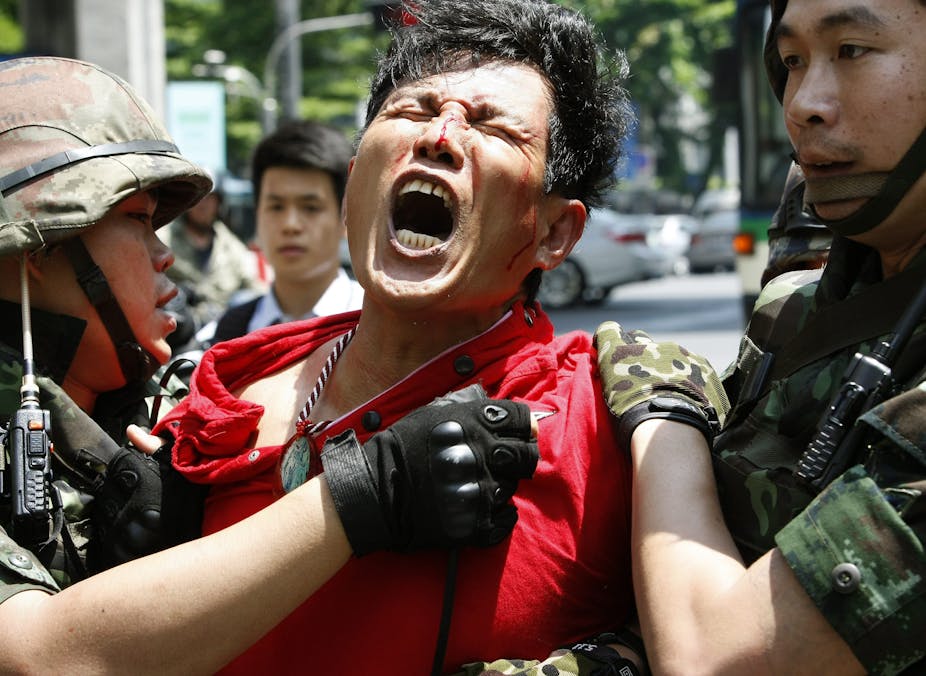Rather than a new dawn for democracy, political and social reform in the region has led to less representation and more contestation. This has potentially far-reaching consequences.
What does the May coup in Thailand have to do with the Bharatiya Janata Party’s landslide election victory in India? What does the recent liberalisation in Myanmar have to do with either?
The connections are not immediately obvious. Yet close inspection reveals intriguing links between these events and others occurring throughout Asia. In a recent study, we argue that Asian states are caught in a cycle of instability based on their post-independence experience.
Because the political, social and economic evolution of many Asian states followed similar patterns, over time the forces of economic and social change exerted similar stresses on them. These stresses have produced a pattern of crisis across the region.
Growth exposes governing agenda’s flaws
Post-independence Asian states worked to balance three objectives: constructing an identity, maintaining government control and building a functional economy. Many relied heavily on pre-colonial legacies and dominant languages to give an aura of permanence to their new borders.
Although democracy prevailed at first, movement towards single-party dominance followed. This included periodic use of internal and external insecurities to tighten the dominant party’s grip on power. Government’s role in economic development grew steadily.
Each of the three objectives – identity, control, economic growth – contained internal contradictions that could only be contained by the other two.
Identity construction relied on increasingly heavy-handed rule and partisan economic frameworks to reconcile majority-minority relations. Strong governments relied on powerful appeals to nationalism and rapid economic growth to justify their lurch into authoritarianism. An assertion of distinctively Asian approaches to governance and development and the freedom of (semi-)authoritarian government to perform command-like economic functions underpinned development.
Perhaps ironically, extraordinary economic growth upset the delicate triangular balance. From this emerged an unsettling mixture of political and social forces inequality, urbanisation, broadening education and awareness, and rising expectations. That led to two waves of political and social contestation across Asia.
The first wave of change
The first occurred between 1986 and 1998. The fall of two dictators, Philippines president Ferdinand Marcos and Indonesian president Suharto, book-ended this period.
From 1986-98, in ten of the 19 states of east, south and southeast Asia, regimes that had held power for decades lost or ceded it to the opposition or consented to democratisation. Another three (in China, Malaysia and Burma) clung to power by forcibly repressing popular democracy movements.
All these transitions reflected demands from the new middle classes for greater political representation. Ultimately, in ten countries the crisis ended with a procedural solution. Democratic processes were established (generally through constitutional rewrites) and single-party dominance was toppled.

Of the many strands woven into these Asian people-power movements, perhaps most dominant was growing fatigue and dwindling self-confidence within the regimes as generational change approached and economic problems mounted. Leadership transitions within single-party regimes exposed the patronage and nepotism lurking beneath the procedural veneer. Some panicking ageing autocrats fatally undermined their legitimacy, as in the killing of Benigno Aquino in the Philippines and the Kwangju massacre in Korea.
With few exceptions, however, reforms enacted between 1986 and 1998 produced poor-quality governments. Rather than full political representation, hybrid regimes emerged. These combined old-fashioned patronage with a widening of the channels for participation but with continuing constraints on political representation and accountability.
As a result, in country after country, voter participation fell and popular frustration with the quality rather than the process of government grew.
The second wave rolls on
The result? A second wave of contestation began in 1999 and is still with us. Mass protests have returned.
In some cases the new democratic politics have deepened social divisions, delegitimising any government for a large number of voters. In Thailand, the distributional politics and generous handouts of whichever party is elected have widened the urban-rural divide. Populations that long enjoyed the benefits of the developmental state have proved deeply reluctant to see others enjoy them.
In Malaysia, minority groups have begun to repudiate the elite inter-ethnic compact underlining the ruling Barisan Nasional’s power and to vote for opposition parties. This has raised new ethnic and religious tensions.
What is dangerous is that these dissatisfactions and confrontations can only mount. It is hard to see how competing claims can be resolved to general satisfaction. Circumventing established adjudication mechanisms, whether judicial or electoral, delegitimises the political processes for maintaining social integration.
Thailand today illustrates the result: political malaise with little hope of a decisive solution. Where ethnic, religious or linguistic suspicion is even deeper, the results could be much more violent.
Half a century after independence then, Asian countries are suffering a crisis of legitimacy. Challenged by new social demands and new political actors, most urgently need a new social contract.
The stakes are high – but so are the opportunities. The question of whether Asia redefines its compact around shared and inclusive governance, growth and identity is critical to its fate in the 21st century. How its states choose to make the necessary changes will have implications far beyond the region.

